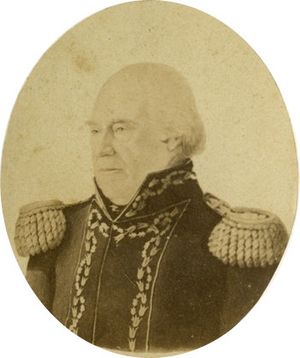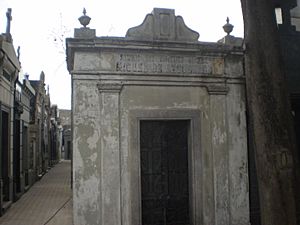Miguel de Azcuénaga facts for kids
Quick facts for kids
Miguel de Azcuénaga
|
|
|---|---|
 |
|
| Voting Member of the Primera Junta | |
| In office May 25, 1810 – April 6, 1811 |
|
| Personal details | |
| Born | June 4, 1754 Buenos Aires |
| Died | December 19, 1833 (aged 79) Buenos Aires |
| Resting place | La Recoleta Cemetery |
| Nationality | Argentine |
| Political party | Patriot |
| Spouse | Justa Rufina de Basavilbaso y Garfias |
| Alma mater | University of Seville |
| Profession | Military |
| Signature | |
| Military service | |
| Allegiance | Viceroyalty of the Río de la Plata, United Provinces of the Río de la Plata |
| Years of service | 1774–1832 |
| Rank | Brigadier |
| Battles/wars | British invasions of the Río de la Plata |
Miguel de Azcuénaga (born June 4, 1754 – died December 19, 1833) was an important Argentine military leader. He studied in Spain at the University of Seville. Azcuénaga started his military career in the Viceroyalty of the Río de la Plata. This was a large Spanish colony that included parts of modern-day Argentina.
He became a key member of the Primera Junta. This was the first independent government of what would become Argentina. Later, he was briefly sent away because he supported a minister named Mariano Moreno. He returned to Buenos Aires when a new government, the First Triumvirate, took over. Miguel de Azcuénaga held many important jobs after that. He was notably the first Governor of Buenos Aires after the May Revolution. He passed away in 1833 at his country home, which is now known as the Quinta de Olivos.
Contents
Who Was Miguel de Azcuénaga?
Early Life and Military Beginnings
Miguel de Azcuénaga was born in Buenos Aires on June 4, 1754. His father, Vicente de Azcuénaga Iturbe, was a Spanish businessman. His mother, María Rosa de Basavilbaso y Urtubia, was from Buenos Aires. Miguel was sent to Spain when he was young. He completed his early studies in Málaga and then went to the University of Seville. He came back to Buenos Aires in 1774.
He started his military career in the artillery unit in Buenos Aires. This was during a war between Spain and Portugal. After the war ended, he became a regidor (a type of city council member) in the Buenos Aires Cabildo. This was the local government of Buenos Aires. In 1778, he took up arms again to fight against attacks from native groups. He led operations at a fort in San Miguel del Monte.
Azcuénaga held several positions in the Buenos Aires Cabildo between 1781 and 1794. He worked to improve the city, like paving streets and fixing buildings. He married his cousin, Justa Rufina de Basavilbaso y Garfias, in 1795.
He became a lieutenant colonel in 1796. He led a local militia until 1802. When he left this role, he gave all his military pay to the soldiers in his unit. In 1802, he was promoted to colonel. He also donated money to help clothe soldiers and build a navy.
A Leader in the May Revolution
Miguel de Azcuénaga played a big part in the events that led to Argentina's independence. In 1806, he fought bravely during the British invasions of the Río de la Plata. He commanded a small group of soldiers who held their position for 20 hours against a much larger British force. Even though his group was small, they fought hard before having to retreat.
Joining the Primera Junta
The Peninsular War in Spain caused big changes in Buenos Aires. The Spanish king was captured, and the local government in Spain fell apart. Many people in Buenos Aires felt that the viceroy (the Spanish governor) no longer had the right to rule. They asked for an open cabildo, which was a special meeting to discuss the situation.
Azcuénaga attended this meeting. He voted for a new government called a Junta, which would have representatives from all the provinces. He even offered his house for secret meetings of those who wanted change. On May 25, 1810, the Primera Junta was formed, and Azcuénaga was chosen as one of its members. He was also promoted to brigadier.
Challenges and Return to Power
The Primera Junta had disagreements among its members. Azcuénaga supported Mariano Moreno, who had more liberal ideas. In 1811, Moreno resigned, and his supporters, including Azcuénaga, were forced to leave their positions. Azcuénaga was sent away to the Mendoza Province. His military rank was taken away.
However, things changed when the Primera Junta was replaced by the First Triumvirate. Azcuénaga was still respected by many. He was allowed to return to Buenos Aires and got his military rank back. There was a small mix-up, and he was first given the rank of colonel again. But by 1814, he was a brigadier once more. He was then appointed Governor of Buenos Aires, overseeing the province's affairs.
Important Roles After Independence
In 1813, a new assembly called the Assembly of the Year XIII was formed. It replaced the Triumvirate with a single head of state, the Supreme Director of the United Provinces of the Río de la Plata. Gervasio Antonio de Posadas became the Supreme Director, and Azcuénaga was chosen as one of his five advisors.
In 1816, the Cabildo appointed him to protect the freedom of the press. He also became a member of the Congress of Tucumán in 1818. This Congress was important because it declared Argentina's independence. Azcuénaga was elected vice-president of the Congress twice. The Congress closed in 1820 after a battle in the Argentine Civil Wars. Like many important people of his time, Azcuénaga was a freemason.
Later Years and Legacy
In 1828, when he was 74 years old, Azcuénaga helped with peace talks. These talks were with the Empire of Brazil after the Argentine-Brazilian War. These discussions led to the creation of the country of Uruguay. He also helped manage the economy in 1829 and 1830. He became a deputy (a type of representative) in 1831 and 1832. Other deputies noted that he attended all the meetings, even though he was very old.
Miguel de Azcuénaga died at his home on December 19, 1833. The governor at the time ordered a special monument, called a cenotaph, to be built for him. This monument is still in place today at the Northern Cemetery, which is now called La Recoleta Cemetery. The official order said that Azcuénaga's great service to the nation, especially during the time of independence, should be remembered forever.
Azcuénaga's country house has a long history. It was built way back in 1580 when Buenos Aires was founded. It was passed down through generations of his family. Eventually, a family member gave it to the Argentine government in 1913. The house was meant to be used as an official residence for the President of Argentina. It was renamed the Quinta de Olivos. Since then, all Argentine presidents have used it.
See also
 In Spanish: Miguel de Azcuénaga para niños
In Spanish: Miguel de Azcuénaga para niños


